A green installation in HVAC (Heating, Ventilation, and Air Conditioning) involves setting up systems and practices that prioritize energy efficiency, sustainability, and minimal environmental impact throughout the installation process. Here are the detailed components of a green HVAC installation:
1. Proper Sizing and Load Calculation
- Accurate Load Calculations: Conducting detailed calculations to determine the exact heating and cooling requirements of the building, avoiding oversized or undersized systems.
- Energy Modeling: Using software to simulate the building’s energy performance and optimize HVAC system selection.
2. High-Efficiency Equipment Selection
- Energy Star Rated Products: Choosing HVAC units that meet or exceed Energy Star standards for energy efficiency.
- High SEER and EER Ratings: Selecting air conditioners and heat pumps with high Seasonal Energy Efficiency Ratio (SEER) and Energy Efficiency Ratio (EER) ratings.
- High AFUE and HSPF Ratings: For furnaces and heat pumps, choosing units with high Annual Fuel Utilization Efficiency (AFUE) and Heating Seasonal Performance Factor (HSPF) ratings.
3. Use of Renewable and Sustainable Materials
- Environmentally Friendly Materials: Utilizing ducts, insulation, and other materials made from recycled or sustainable sources.
- Low-VOC Products: Selecting paints, sealants, and adhesives with low volatile organic compound (VOC) emissions to improve indoor air quality.
4. Optimized System Design
- Ductwork Design: Designing duct systems with minimal bends and resistance to reduce energy losses. Properly sealing and insulating ducts to prevent leaks.
- Zoning Systems: Implementing zoning to provide independent control for different areas of the building, improving comfort and reducing energy consumption.
5. Integration with Renewable Energy Sources
- Solar Integration: Installing HVAC systems that can be powered by on-site solar panels.
- Geothermal Systems: Using ground-source heat pumps that leverage the earth’s stable temperatures for efficient heating and cooling.
6. Advanced Control Systems
- Smart Thermostats: Installing programmable or learning thermostats that optimize heating and cooling schedules based on occupancy and preferences.
- Building Automation Systems (BAS): Integrating HVAC controls with building automation for real-time monitoring and adjustments.
7. Energy Recovery Ventilation
- Heat Recovery Ventilators (HRVs) and Energy Recovery Ventilators (ERVs): Installing systems that capture energy from exhaust air to pre-condition incoming fresh air, reducing heating and cooling loads.
8. Efficient Installation Practices
- Proper Placement of HVAC Units: Ensuring outdoor units are placed in shaded, well-ventilated areas to improve efficiency.
- Correct Refrigerant Charge: Ensuring the refrigerant is charged correctly to maximize system efficiency and lifespan.
- Quality Installation Checks: Performing thorough commissioning and testing to verify system performance and identify any issues.
9. Water Conservation Measures
- Efficient Cooling Towers: Using closed-loop systems and water-saving technologies to reduce water usage.
- Condensate Recovery: Capturing and reusing condensate water for cooling tower makeup water or irrigation.
10. Sustainable Practices During Installation
- Waste Management: Recycling and properly disposing of old HVAC equipment and installation debris.
- Minimizing Site Impact: Reducing site disturbances and using low-impact installation methods.
11. Maintenance and Monitoring
- Predictive Maintenance Systems: Installing sensors and IoT devices to monitor system performance and predict maintenance needs.
- Remote Monitoring: Allowing for continuous system performance monitoring and adjustments to ensure optimal operation.
12. Educational and Operational Support
- User Training: Educating building occupants and maintenance staff on how to use and maintain the HVAC system efficiently.
- Operational Guides: Providing detailed manuals and guidelines for sustainable operation and maintenance practices.
13. Compliance with Green Building Standards
- LEED Certification: Ensuring the HVAC installation contributes to achieving Leadership in Energy and Environmental Design (LEED) certification.
- ASHRAE Standards: Following guidelines from the American Society of Heating, Refrigerating, and Air-Conditioning Engineers (ASHRAE) for energy-efficient design and operation.
By focusing on these aspects, a green HVAC installation can significantly enhance energy efficiency, reduce environmental impact, and improve indoor air quality, leading to more sustainable and cost-effective building operations.
Looking to install a commercial HVAC System or Duct work in your Business Area?
Contact Vipul Ac to learn about our HVAC Service
Call +91 9825636606 Today.


